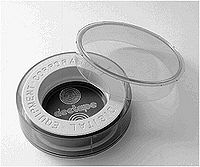DECtape
DECtape was a low-cost, low-capacity tape magnetic storage system intended for storage of small data entities (e.g. programs).
It used 3/4-inch wide tape on small 4-inch reels, formatted before use into fixed-sized blocks which could be individually read or written. This differs from conventional magnetic tape, which could only be written at the end of the previously-written area of the tape.
DECtape was random access, so the drive had the ability to move forward and backwards to the desired block. The tape format included a block number at the start and end of each block, to help the drive find the desired block. Tapes could be read and written while moving in either direction, which meant that when seeking backwards to the target block, it was not necessary to bring the tape to a halt, and reverse it, before reading the data.
DECtape also had exceptional reliability; it used a very simple and brute-force mechanism to produce that: it wrote all tracks in duplicate on each half of the tape. It was possible to punch a hole in a DECtape with a paper punch and leave the tape readable.
The drive had a single head, and used hydro-dynamic lubrication to reduce wear on the tape; like disk heads, the tape floated on a layer of air while the tape was moving, without touching any metal. (In a test, a tape make 30,000 passes over a head without significant wear.)
DEC produced two DECtape drives; the single TU55, and the dual TU56. Controllers for them existed for the PDP-8, PDP-10, PDP-11 and PDP-15, among others. Not all DECtape controllers supported reading in the reverse direction, however.
History
The predecessor of DECtape was LINC tape, created in 1961 as the primary storage medium for the LINC computer.
Although almost compatible (the drives on the PDP-12 could support both LINC tapes and DECtapes), there were minor differences between the two: e.g. the location of the feed and take-up reels were reversed between the two, and the mark track format differed considerably, to support bi-directional read and write (the LINC tape could read and write in the forward direction only).
DECtape was originally called Microtape. As a pun on this, IBM 7 and 9 track tape was sometimes called Macrotape.
Tape format
The tape contained timing and mark tracks along with three data tracks; the first two allowed not only the ability to re-write individual blocks, but also meant that it could operate with varying tape speeds - the drives did not have capstans, so tape motion was controlled by the motors which drove the reels, and tape speed did vary considerably.
Since each 'line' on the tape contained only three bits, a 12-bit word took four lines to store, and 16/18-bit words took 6 lines. (16-bit machines used 18-bit words on the tape, but normally ignored two of the bits.) Blocks were potentially of different sizes, but normally were all a single size: 128 12-bit words, 256 16/18-bit, or 128 36-bit words. A tape could hold 184K 12-bit words, or 144K 16/18-bit words.
The block format included checksums, guard words to protect the block numbers, along with an inter-block zone. The tape format included end zones and extension areas on each end of the tape; the former was to prevent the tape running off the reels, and the latter to allow reel acceleration before reading/writing starts.
Specifications
- Tape - 3/4 inch x 260 feet; 1 mil Mylar sandwich tape (Mylar on both sides)
- Tape speed - 97 inches/second (+/- 14 ips)
- Reading/writing rate - 30K lines/second (33-1/3 micro-seconds/line)
- Density - 350 lines/inch (+/- 55 lpi)
- Tape capacity - 147,968 16/18 bit words, in 578 blocks of 256 words each
- Start time - 150 milliseconds (+/- 15 msec)
- Stop time - 100 milliseconds (+/- 15 msec)
- Reverse time - 200 milliseconds (+/- 20 msec)
(Specifications may vary slightly between TU55 and TU56 transports.)
